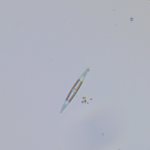Detected Species
-
HAB Species
- Diatoms
- Dinoflagellates
- Cyanobacteria
- Raphidophytes
- Haptophytes
-
Non-toxic Species
- Diatoms
- Dinoflagellates
Contact Us:
Mihaela D. Enache, Ph.D., Project Manager & Co-PI, Research Scientist I, Division of Science and Research, NJDEP (mihaela.enache@dep.nj.gov)
Ling Ren, Ph.D., PI, Research Assistant Professor, College of Science, George Mason University (lren2@gmu.edu)
Haslea ostrearia
Morphology
Cells are lanceolate in valvar view, with acute endings. Cell length about 45-50 μm and width about 5-7 μm in the central area. The characteristic water-soluble blue pigments, ‘marenine’, are visible at apices.
Toxins and toxicity
Not toxic.
Ecology
The blue pigment can cause the greening of oyster gills, ‘’Green Oyster’, in farming ponds. We found this species but sometimes with very weak or without blue pigments.
Distribution and Occurrence
A marine benthic/tychopelagic species (or benthic-periphytic phytoplankton). Common, recorded from the Northern Atlantic coasts (both European and North American), Indian Ocean coast of South Africa, Australia. In this study, it was highly abundant in REF-1 in spring (March-April).
References
Biološki Odsjek, Prirodoslovno-matematički fakultet, Sveučilište u Zagrebu, M. Mejdandžić, S. Bosak, and Z. Ljubešić. 2017. Blue Diatoms: Global Phenomenon of ˝Greening˝ in Shellfish and Record of Planktonic Haslea Species in the South Adriatic Sea. Naše more 64: 38–44. doi:10.17818/nm/2017/1.7
Dąbek, P., R. Gastineau, T. G. Bornman, C. Lemieux, M. Turmel, G. Hallegraeff, J.-L. Mouget, and A. Witkowski. 2022. The blue diatom Haslea ostrearia from the Indian Ocean coast of South Africa, with comparative analysis of Haslea organellar genomes. Front. Mar. Sci. 9. doi:10.3389/fmars.2022.950716
